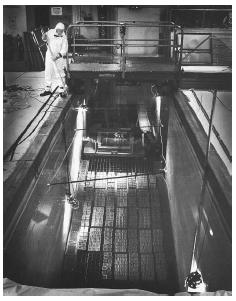Brookhaven National Laboratory
█ K. LEE LERNER
Founded in 1947, Brookhaven National Laboratory is operated for the U.S. Department of Energy by Brookhaven Science Associates, a non-profit research company.
At Brookhaven, a staff of approximately 3,000 scientists, engineers, and technical support staff work alongside an additional 4,000 scientists and engineers who annually visit the facilities located on Long Island, New York.
Although research at Brookhaven impacts both basic science and national security related science issues, following the September 11, 2001, terrorist attacks on the United States, Brookhaven established an interdisciplinary working group to tackle specific issues related to counter-terrorism. The focus of the group is to oversee the development of technologies devoted to prediction, detection, and preemption, of terrorism.
An important component of Brookhaven projects is the development of sensors useful in detecting nuclear, chemical, and biological agents. For example, highly sensitive chemical sensors can detect explosives, and radiation detectors are useful in detecting contact with nuclear materials. Highly sensitive detectors are capable of measuring trace amounts in concentrations so small that the sensors can provide evidence of prior contact with suspect materials—even if the materials are no longer physically present.
Facilities at Brookhaven include a thermal neutron imaging camera that can detect radiation source emanation at distances up to approximately 200 feet. In addition, Brookhaven sensor systems utilize a number of physical properties—from laserscattering patterns to microwave probes—to interrogate unknown materials.
Biotechnology research at Brookhaven includes the development of vaccines to combat the deleterious effects of a broad spectrum of biological weapons and chemical

nerve gas agents. Antidote treatment research includes the development of topical creams that contain enzymes capable of degrading nerve agents.
To facilitate rescue of individuals in debris of collapsed buildings, Brookhaven engineers designed devices to help remove debris and to image debris fields. Magnetic imaging equipment can locate damaged structural elements (e.g., iron girders) and allow rescue personnel to evaluate structural integrity and identify possible areas of survival.
Brookhaven scientists and engineers developed the Mini-Raman Lidar System (MRLS) that is capable of detecting trace amounts of dangerous chemicals (including illegal narcotics and other drugs). Laser scattering devices can also detect distinct chemical profiles or "fingerprints." MRLS allows investigators to detect those chemical associated with the processing of nuclear fuels. Because MRLS is highly sensitive, inspectors can examine questionable objects from safer distances. In many cases, MRLS can accurately detect trace molecules at distances ranging from three to ten feet. Given the proper environmental controls, MRLS can detect trace molecules at far greater distances.
Another recent national security related project at Brookhaven National Laoratory involved the development of the Large-Volume Radiation Detector that uses compressed xenon as part of a portable, battery powered, room-temperature spectrometer unit. The spectrometer is very sensitive and offers high discrimination and resolution at levels that allow investigators the ability to distinguish between isotopes used in medical products and those associated with prohibited nuclear activities. Investigators are hopeful that the success of the small scale detector will allow construction of larger units using similar technology that are capable of rapidly examining large cargo loads (e.g., bulk cargoes at truck terminals, ports, etc.) at safer "standoff" distances.
Other research facilities include a relativistic heavy ion collider, alternating gradient synchrotron, synchrotron light source, tandem Van de Graaff accelerators, high-field MRI, positron emission tomograpahy (PET) facilities, transmission electron (TEM) and scanning (SEM) electron microscopes, a laser electron accelerator facility (LEAF), and other accelerator test facilities including 60-inch and 40-inch cyclotrons.
█ FURTHER READING:
ELECTRONIC:
United States Department of Energy, Office of Science. National Laboratories and User Facilities. < http://www.sc.doe.gov/Sub/Organization/Map/national_labs_and_userfacilit es.htm > (March 23, 2003).
United States Department of Homeland Security. Research & Technology. < http://www.dhs.gov/dhspublic/display?theme=27&content=374 > (March 23, 2003).
Brookhaven National Laboratory. March 26, 2003. < http://www.bnl.gov/world/ > (April 2, 2003).
SEE ALSO
Argonne National Laboratory
DOE (United States Department of Energy)
Environmental Measurements Laboratory
Lawrence Berkeley National Laboratory
Lawrence Livermore National Laboratory (LLNL)
Los Alamos National Laboratory
NNSA (United States National Nuclear Security Administration)
Oak Ridge National Laboratory (ORNL)
Pacific Northwest National Laboratory
Plum Island Animal Disease Center
Sandia National Laboratories
Comment about this article, ask questions, or add new information about this topic: